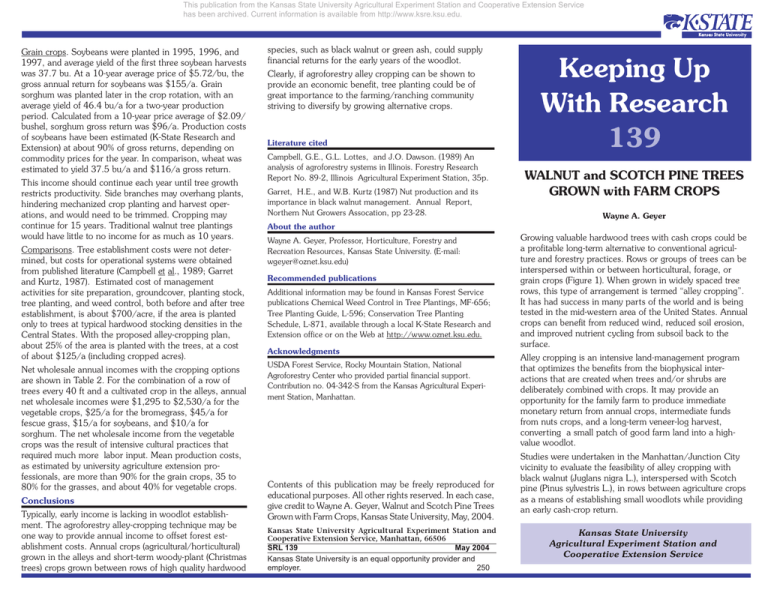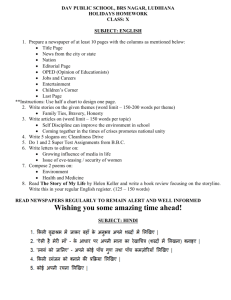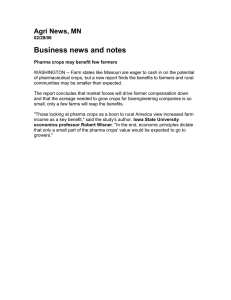
This publication from the Kansas State University Agricultural Experiment Station and Cooperative Extension Service
has been archived. Current information is available from http://www.ksre.ksu.edu.
Grain crops. Soybeans were planted in 1995, 1996, and
1997, and average yield of the first three soybean harvests
was 37.7 bu. At a 10-year average price of $5.72/bu, the
gross annual return for soybeans was $155/a. Grain
sorghum was planted later in the crop rotation, with an
average yield of 46.4 bu/a for a two-year production
period. Calculated from a 10-year price average of $2.09/
bushel, sorghum gross return was $96/a. Production costs
of soybeans have been estimated (K-State Research and
Extension) at about 90% of gross returns, depending on
commodity prices for the year. In comparison, wheat was
estimated to yield 37.5 bu/a and $116/a gross return.
This income should continue each year until tree growth
restricts productivity. Side branches may overhang plants,
hindering mechanized crop planting and harvest operations, and would need to be trimmed. Cropping may
continue for 15 years. Traditional walnut tree plantings
would have little to no income for as much as 10 years.
Comparisons. Tree establishment costs were not determined, but costs for operational systems were obtained
from published literature (Campbell et al., 1989; Garret
and Kurtz, 1987). Estimated cost of management
activities for site preparation, groundcover, planting stock,
tree planting, and weed control, both before and after tree
establishment, is about $700/acre, if the area is planted
only to trees at typical hardwood stocking densities in the
Central States. With the proposed alley-cropping plan,
about 25% of the area is planted with the trees, at a cost
of about $125/a (including cropped acres).
Net wholesale annual incomes with the cropping options
are shown in Table 2. For the combination of a row of
trees every 40 ft and a cultivated crop in the alleys, annual
net wholesale incomes were $1,295 to $2,530/a for the
vegetable crops, $25/a for the bromegrass, $45/a for
fescue grass, $15/a for soybeans, and $10/a for
sorghum. The net wholesale income from the vegetable
crops was the result of intensive cultural practices that
required much more labor input. Mean production costs,
as estimated by university agriculture extension professionals, are more than 90% for the grain crops, 35 to
80% for the grasses, and about 40% for vegetable crops.
Conclusions
Typically, early income is lacking in woodlot establishment. The agroforestry alley-cropping technique may be
one way to provide annual income to offset forest establishment costs. Annual crops (agricultural/horticultural)
grown in the alleys and short-term woody-plant (Christmas
trees) crops grown between rows of high quality hardwood
species, such as black walnut or green ash, could supply
financial returns for the early years of the woodlot.
Clearly, if agroforestry alley cropping can be shown to
provide an economic benefit, tree planting could be of
great importance to the farming/ranching community
striving to diversify by growing alternative crops.
Literature cited
Campbell, G.E., G.L. Lottes, and J.O. Dawson. (1989) An
analysis of agroforestry systems in Illinois. Forestry Research
Report No. 89-2, Illinois Agricultural Experiment Station, 35p.
Garret, H.E., and W.B. Kurtz (1987) Nut production and its
importance in black walnut management. Annual Report,
Northern Nut Growers Assocation, pp 23-28.
Keeping Up
With Research
139
WALNUT and SCOTCH PINE TREES
GROWN with FARM CROPS
Wayne A. Geyer
About the author
Wayne A. Geyer, Professor, Horticulture, Forestry and
Recreation Resources, Kansas State University. (E-mail:
wgeyer@oznet.ksu.edu)
Recommended publications
Additional information may be found in Kansas Forest Service
publications Chemical Weed Control in Tree Plantings, MF-656;
Tree Planting Guide, L-596; Conservation Tree Planting
Schedule, L-871, available through a local K-State Research and
Extension office or on the Web at http://www.oznet.ksu.edu.
Acknowledgments
USDA Forest Service, Rocky Mountain Station, National
Agroforestry Center who provided partial financial support.
Contribution no. 04-342-S from the Kansas Agricultural Experiment Station, Manhattan.
Contents of this publication may be freely reproduced for
educational purposes. All other rights reserved. In each case,
give credit to Wayne A. Geyer, Walnut and Scotch Pine Trees
Grown with Farm Crops, Kansas State University, May, 2004.
Kansas State University Agricultural Experiment Station and
Cooperative Extension Service, Manhattan, 66506
SRL 139
May 2004
Kansas State University is an equal opportunity provider and
employer.
250
Growing valuable hardwood trees with cash crops could be
a profitable long-term alternative to conventional agriculture and forestry practices. Rows or groups of trees can be
interspersed within or between horticultural, forage, or
grain crops (Figure 1). When grown in widely spaced tree
rows, this type of arrangement is termed “alley cropping”.
It has had success in many parts of the world and is being
tested in the mid-western area of the United States. Annual
crops can benefit from reduced wind, reduced soil erosion,
and improved nutrient cycling from subsoil back to the
surface.
Alley cropping is an intensive land-management program
that optimizes the benefits from the biophysical interactions that are created when trees and/or shrubs are
deliberately combined with crops. It may provide an
opportunity for the family farm to produce immediate
monetary return from annual crops, intermediate funds
from nuts crops, and a long-term veneer-log harvest,
converting a small patch of good farm land into a highvalue woodlot.
Studies were undertaken in the Manhattan/Junction City
vicinity to evaluate the feasibility of alley cropping with
black walnut (Juglans nigra L.), interspersed with Scotch
pine (Pinus sylvestris L.), in rows between agriculture crops
as a means of establishing small woodlots while providing
an early cash-crop return.
Kansas State University
Agricultural Experiment Station and
Cooperative Extension Service
This publication from the Kansas State University Agricultural Experiment Station and Cooperative Extension Service
has been archived. Current information is available from http://www.ksre.ksu.edu.
Financial costs and returns (1997) were evaluated after
seven growing seasons for cultivated crops (expected
duration of 15 years) according to K-State Research and
Extension Farm and Horticultural Management Guide
sheets. All analyses include rent for farmland. Returns from
Christmas tree products begin at years 8 through 12 from
Scotch pine, from firewood products after 20 years, from
walnut nut-crop production at 10 to 50 years, and from
fine hardwood logs at 50 years.
Figure 1. Schematic of alley cropping.
Procedures
An alley cropping arrangement was planted in 1994,
alternating single rows of tree species with agricultural
cash crops. Ten rows of 1:0 seedlings of black walnut and
Scotch pine were planted alternately 8 ft apart in 40-ft
rows, for a total of 380 trees. A randomized complete
block field design was used. Weed control was with herbicides or one of two types of plastic weed barrier. Field
measurements included survival, total height, diameter,
stem form, and crown shape.
The crops planted in the alleys were forages (smooth
bromegrass - Bromus inermis Leyss.); grains (soybean Glycine max (L.) Merr. ‘Makin’ ); milo - Sorghum bicolor
L.); or vegetables (tomatoes - Lycopersicon esculentum
Mill. ‘Mountain Pride’; western shipping type muskmelon Curcurbita pepo L. ‘Magnum 45’; large and decorative
pumpkins; and sweet corn - Zea mays L.). Black woven
fiber plastic mulch and drip irrigation were used with the
vegetable crops in three replicated plantings. Smooth
bromegrass and soybean plantings were made the following fall and spring in six additional plots. The soybean
and vegetable crops were grown on the same land for two
consecutive years, then their positions were exchanged in
the third year. Two-year rotation cycles were followed.
Muskmelons were harvested three times a week, and
number, quality, and total weight of the marketable fruit
were recorded. Tomatoes were harvested once a week,
and total weights of marketable fruit were recorded. At fall
har-vest, the number and weights of pumpkins were
recorded. During the fourth planting season (1997), three
types of sweet corn each were planted in two full-length
plot rows. In succeeding years, milo was planted in the
agricultural plots. Tall fescue was grown in the borders.
Results and Discussion
Tree crops. Seventh-year survival of the trees did not differ
among weed-control methods. Most tree mortality occurs
during the first season of growth. Overall survival of the
walnut was more than 98%. Mean height of the walnut
trees was13.5 ft. (Table 1). At three years, total height of
the trees in the herbicide treated plots was only 63% that
of the fabric-mulched plots, but at seven years the height of
the herbicide treated plots improved to 83% that of the
fabric-mulched plots. Diameter growth for trees treated
with herbicides was 73% of that for trees in fabric-mulched
Table 1. Seventh-year growth of
plots. A few walnut trees
black walnut and pine in an alleybore nuts at five years.
cropping configuration.
Overall survival of pines
was 97.4%. Mean height
Walnut
Pine
of pines was 3.97 ft, with
Survival
98.5%
97.4%
no difference between
Height
13.5 ft
3.97 ft
treatments. Trees can
Diameter
2.29 in
begin to be harvested for
Christmas tree use when they are at least six ft tall.
Stem form (lower 10 ft of the bole) of the walnut at this
early age included many poorly shaped boles. The number
of straight boles was about 25% (Figure 2), less than
expected. The trees were spaced at 8 by 40 ft. apart, thus
they are more susceptible to wind damage. Herbicides
were not as effective as expected, possibly because they
were applied late and weather was dry, resulting in weed
competition and reduced growth.
Figure 2. Stem form of walnut and crown form of pine trees.
Crown shape of the pine was excellent; 75% of the trees
had a conical shape, but some were of poor form, even
after three years of shearing (Figure 2).
Vegetable crops. A tree row spacing of 40 ft with 6-ft
weed-barrier rows left about 34 ft (75% of available land)
for alternative crop production. Five raised, black-plasticcovered beds (5 ft apart) with drip irrigation were used in
this study. Summer fruit yields (Table 2) differed by year for
the commercial tomatoes, western-shipping type muskmelons, and pumpkins (1994, 1995, 1996). Gross annual
returns for wholesale and retail sales, respectively, were
based on prices of $0.20 and $1.00/lb for tomatoes,
$0.40 and $1.00 each for muskmelons, $0.25 and $1.25
each for Munchins pumpkin, $0.10 and $0.25/lb for large
Jackpot pumpkins, and $1.75 and $3.00 per dozen for
Table 2. Annual crop yields and returns from agroforestry alleycropping study.
Crop Type
Yield
Wholesale
Net Return
---------- $/per acre ---------Horticultural
(lbs/acre)
Tomatoes (3 yrs)
23,021
4,601
2,530
Melons (3 yrs)
18,634
1,845
1,295
Pumpkins (3 yrs)
24,540
3,975
2,185
Sweet corn (1 yr)
6,641
1,448
795
Grain
(bu)
Soybeans (3 yrs)
2,239 (37.7)
155
15
Grain sorghum (2 yrs) 2,598 (46.4)
96
10
Wheat (estimated)
2,250 (37.5)
116
10
Forage
(tons)
Alfalfa (estimated)
6,000 (4.0)
270
150
Bromegrass (5 yrs)
3,993 (2.0)
131
25
Fescue 31 (3 yrs)
3,839 (1.9)
126
45
Note: Area in tree rows (25%) is included in these per-acre rate
evaluations, and cost for tree establishment is excluded.
sweet corn. The return for muskmelons was half that of
tomatoes and pumpkins. Cash values are per-acre rates
(Table 2) that include the land used for tree production
(25%). Costs for the vegetable crops are estimated to be
about 40% of the gross income, according to K-State
Research and Extension publications.
Forage crops. Smooth bromegrass was planted at recommended rates in the fall of 1994 and harvested in midJune each year. Average yield of the replicated plots was
2.0 tons/a. The gross annual income from the harvested
acres was $131/a, calculated at an average price of $66/
ton. Production costs are high, 90% of gross returns.
Kentucky 31 fescue was planted adjacent to the research
plots and showed yields slightly less than those of
bromegrass, with an average yield of 1.9 tons/a. In
comparison, alfalfa was estimated at 4 tons/a and a gross
return of $270.








